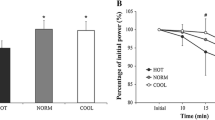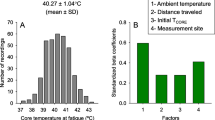Abstract
We examined differences in dynamic heat balance between males and females during intermittent exercise. Six males (M) and six females (F) performed three 30-min bouts of exercise (Ex1, Ex2, Ex3) at a constant rate of metabolic heat production (\( \dot{M} - \dot{W} \)) of ~500 W separated by three 15-min periods of inactive recovery. Rate of total heat loss (\( \dot{H}_{\text{L}} \)) was measured by direct calorimetry, while \( \dot{M} - \dot{W} \) was determined by indirect calorimetry. Esophageal (T es) was measured continuously. Exercise at a constant \( \dot{M} - \dot{W} \) of ~500 W, was paralleled by a similar \( \dot{H}_{\text{L}} \) between sexes at the end of Ex1 (M: 462 ± 30 W, F: 442 ± 9 W, p = 0.117), Ex2 (M: 468 ± 28 W, F: 508 ± 18 W, p = 0.343), and Ex3 (M: 469 ± 17 W, F: 465 ± 13 W, p = 0.657). Consequently, changes in body heat content were comparable after Ex1 (M: 218 ± 21 kJ, F: 287 ± 35 kJ, p = 0.134), Ex2 (M: 109 ± 18 kJ, F: 158 ± 29 kJ, p = 0.179), and Ex3 (M: 92 ± 19 kJ, F: 156 ± 35 kJ, p = 0.136). However, females had greater overall increases in T es at the end of Ex3 (M: 0.55 ± 0.25°C, F: 0.97 ± 0.26°C, p ≤ 0.05). Differences in core temperature between sexes appear to be solely related to differences in physical characteristics, and not due to concurrent differences in whole-body thermoregulatory responses.



Similar content being viewed by others
References
Anderson GS (1999) Human morphology and temperature regulation. Int J Biometeorol 43:99–109. doi:10.1007/s004840050123
Austin DM, Lansing MW (1986) Body size and heat tolerance: a computer simulation. Hum Biol 58:153–169
Behnke A, Wilmore J (1974) Evaluation and regulation of body build and composition. Prentice-Hall, Englewood Cliffs
Burse RL (1979) Sex differences in human thermoregulatory response to heat and cold stress. Hum Factors 21:687–699
Cheung SS, McLellan TM, Tenaglia S (2000) The thermophysiology of uncompensable heat stress. Physiological manipulations and individual characteristics. Sports Med 29:329–359. doi:10.2165/00007256-200029050-00004
DuBois D, DuBois EF (1916) A formula to estimate the approximate surface area if height and weight be known. Arch Intern Med 17:863–871
Gagge AP, Gonzales RR (1996) Mechanisms of heat exchange. Handbook of physiology. Environmental physiology. American Physiological Society, Bethesda, pp 45–84
Gandhi OP, Lazzi G, Furse CS (1996) Electromagnetic absorption in the human head and neck for mobile telephones at 835 and 1900 MHz. IEEE Trans on Microwav Theo and Techn
Geddes LA, Baker LE (1967) The specific resistance of biological material—a compendium of data for the biomedical engineer and physiologist. Med Biol Eng 5:271–293. doi:10.1007/BF02474537
Hardy J, DuBois E (1938) The technique of measuring radiation and convection. J Nutr 15:461–475
Havenith G (2001a) Human surface to mass ratio and body core temperature in exercise heat stress—a concept revisited. J Therm Biol 26:387–393. doi:10.1016/S0306-4565(01)00049-3
Havenith G (2001b) Individualized model of human thermoregulation for the simulation of heat stress response. J Appl Physiol 90:1943–1954
Havenith G, Coenen JM, Kistemaker L, Kenney WL (1998) Relevance of individual characteristics for human heat stress response is dependent on exercise intensity and climate type. Eur J Appl Physiol 77:231–241. doi:10.1007/s004210050327
Jay O, Kenny GP (2007) The determination of changes in body heat content during exercise using calorimetry and thermometry. J Hum Environ Syst 10:19–29. doi:10.1618/jhes.10.19
Jay O, Gariepy LM, Reardon FD, Webb P, Ducharme MB, Ramsay T, Kenny GP (2007) A three-compartment thermometry model for the improved estimation of changes in body heat content. Am J Physiol Regul Integr Comp Physiol 292:R167–R175. doi:10.1152/ajpregu.00338.2006
Marino F, Mbambo Z, Kortekaas E, Wilson G, Lambert M, Noakes T, Dennis S (1999) Advantages of smaller body mass during distance running in warm, humid environments. Pflugers Arch 441:359–367. doi:10.1007/s004240000432
Mekjavic IB, Rempel ME (1990) Determination of esophageal probe insertion length based on standing and sitting height. J Appl Physiol 69:376–379
Nishi Y (1981) Measurement of thermal balance in man. In: Cena K, Clark J (eds) Bioengineering, thermal physiology and comfort. Elsevier, New York, pp 29–39
Nunneley SA (1978) Physiological responses of women to thermal stress: a review. Med Sci Sports 10:250–255
Reardon FD, Leppik KE, Wegmann R, Webb P, Ducharme MB, Kenny GP (2006) The Snellen human calorimeter revisited, re-engineered and upgraded: design and performance characteristics. Med Biol Eng Comput 44:721–728. doi:10.1007/s11517-006-0086-5
Shapiro Y, Pandolf KB, Avellini BA, Pimental NA, Goldman RF (1980) Physiological responses of men and women to humid and dry heat. J Appl Physiol 49:1–8
Simunic D, Wach P, Renhart WRS (1996) Spatial distribution of high-frequency electromagnetic energy in human head during MRI: numerical results and measurements. IEEE Trans Biomed Eng 43:88–94. doi:10.1109/10.477704
Webb P (1985) Human calorimeters. Praeger, New York
Wenger CB (1972) Heat of evaporation of sweat: thermodynamic considerations. J Appl Physiol 32:456–459
Wyndham CH, Morrison JF, Williams CG (1965) Heat reactions of male and female Caucasians. J Appl Physiol 20:357
Acknowledgments
This research was supported by the Natural Sciences and Engineering Research Council (Grant # RGPIN-298159-2004, held by Dr. Glen P. Kenny) and Material Command’s Office of the Congressionally Directed Medical Research Programs (Grant DAMD17-02-2-0063, held by Dr. Glen P. Kenny). Dr. Glen P. Kenny was supported by a University of Ottawa Research Chair Award.
Author information
Authors and Affiliations
Corresponding author
Rights and permissions
About this article
Cite this article
Gagnon, D., Dorman, L.E., Jay, O. et al. Core temperature differences between males and females during intermittent exercise: physical considerations. Eur J Appl Physiol 105, 453–461 (2009). https://doi.org/10.1007/s00421-008-0923-3
Accepted:
Published:
Issue Date:
DOI: https://doi.org/10.1007/s00421-008-0923-3




